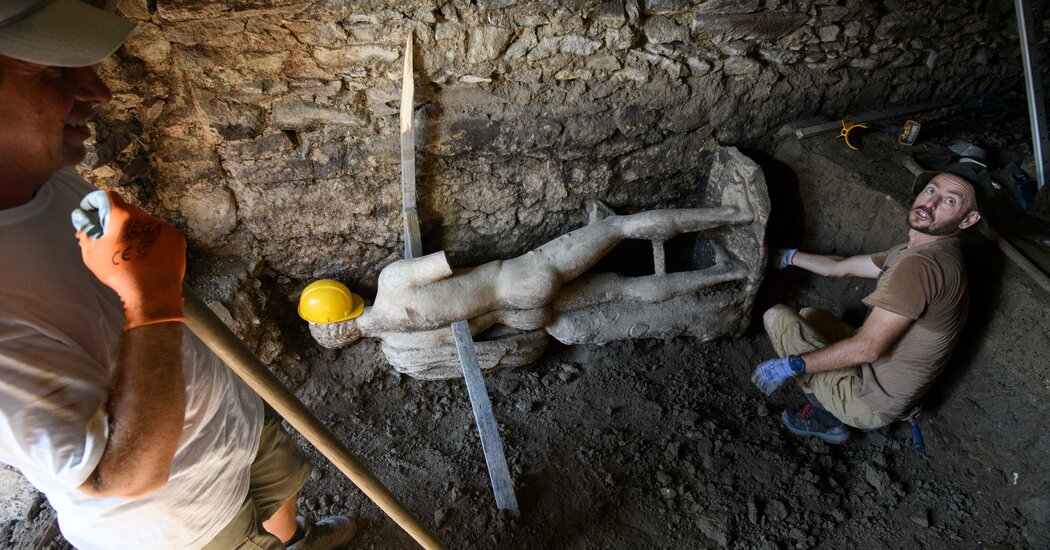Archaeologists in Bulgaria made an unexpected discovery last week in an ancient Roman sewer: a well-preserved marble statue, taller than a man.
“We found it by accident,” said Lyudmil Vagalinski, the scientific director of the excavation. “It was amazing. A whole statue appeared before us.”
The discovery could shed light on how people in the area, now Bulgaria, fought to preserve their religion as Christianity swept the ancient world. The sewer may have been a hiding place used by pagans to protect the imposing statue from Christian fanatics, who sometimes smashed the heads of pagan gods.
It appears they have succeeded: the researchers have not yet excavated the entire statue, but the face and head show no signs of destruction.
“It’s a miracle it survived,” said Dr. Vagalinski.
He and his colleagues were working on a routine excavation last week near the village of Rupite, close to Bulgaria’s southwestern border with Greece. During the scorching summer heat, they discovered marble in the ground.
They were trying to contain their excitement, Dr. Vagalinski said, as a marble foot emerged. Then they saw careful notches on the toenails. Legs came up. A torso followed. And finally a head.
“It was just waiting for us,” he said. Almost as if the statue had found them, and not the other way around.
This wouldn’t be the first ancient statue to emerge from a seedy trench: construction workers in Rome also found a marble statue found last year in a sewer system, probably depicting Hercules.
The Bulgarian statue—which Dr. Vagalinski believes represents the god Hermes—may have been buried in the late fourth century. He thinks it was placed in the sewer a few years after 380 A.D., the year Emperor Theodosius I declared Christianity the official religion of the Roman Empire.
The pagans in the ancient city where the statue was found, then called Heraclea Sintica, may have wanted to protect their treasures from Christian destruction.
“They tried to secretly preserve the memory of these deities,” Dr. Vagalinski said.
He also thinks the statue may have been buried sometime after 388 A.D., when a major earthquake struck the area and destroyed the city. It appears to have destroyed the infrastructure to the point that the sewage system was no longer functioning, he said.
But even though the sewer was out of use after the earthquake, Dr. Vagalinski added, it was still strong and became a kind of burial ground for pagan history.
“While we might not think a sewer is the right place, at least it would be unharmed,” said the Reverend Professor Martin Henig, an expert on Roman art at the University of Oxford who was not involved in the dig. “Nobody would touch the sewer,” he added.
The statue is missing part of its right arm, which almost looks as if it has been amputated, Dr. Vagalinski said. The left hand may also be damaged. But otherwise the statue appears largely intact.
“It is rare and exciting to find a nearly perfectly intact statue, and especially one of such apparently high quality,” Elizabeth Marlowe, the director of the museum studies program at Colgate University, who was not involved in the excavations, wrote in an email.
The statue’s geographic location can also offer researchers insights. Many such well-preserved statues have been looted, Dr. Marlowe wrote, and “turn up seemingly out of nowhere in dealers’ shops in Switzerland or New York.”
This can mean that the finds, while remarkable, are often devoid of clues about their origins. (Smugglers go to great lengths to erase these details in order to hamper cultural officials who are trying to return the artifacts to the places where they were found.)
“If this had come onto the art market, we would never in a million years have guessed that it came from a small town in the Bulgarian hinterland,” Dr. Marlowe wrote. “We would have guessed that it came from a wealthy city or a private estate in Italy.”
Such an impressive marble statue — which she said was a rare find in southwestern Bulgaria — could be useful in understanding Heraclea Sintica. Dr. Marlowe said the city was not a known Roman site. “This has the potential to greatly enrich our understanding of the local culture of this region,” she wrote.
Dr. Vagalinski and his team are now focused on carefully removing the statue. Once it is fully excavated, which he hopes will happen this week, he and other researchers will date and analyze the piece — before preparing it for display at the local history museum.
“It’s a sensation,” he said. “You rarely find such huge images.”
Boryana Jambagova contributed to the reporting.


